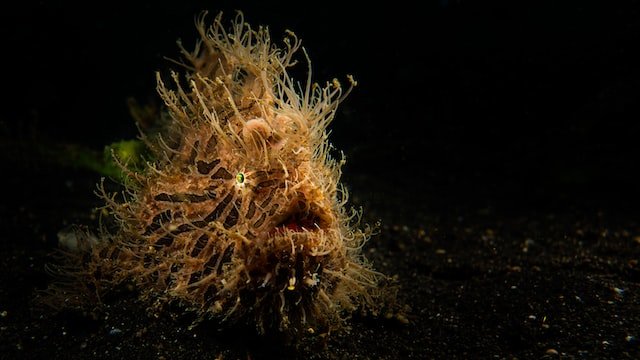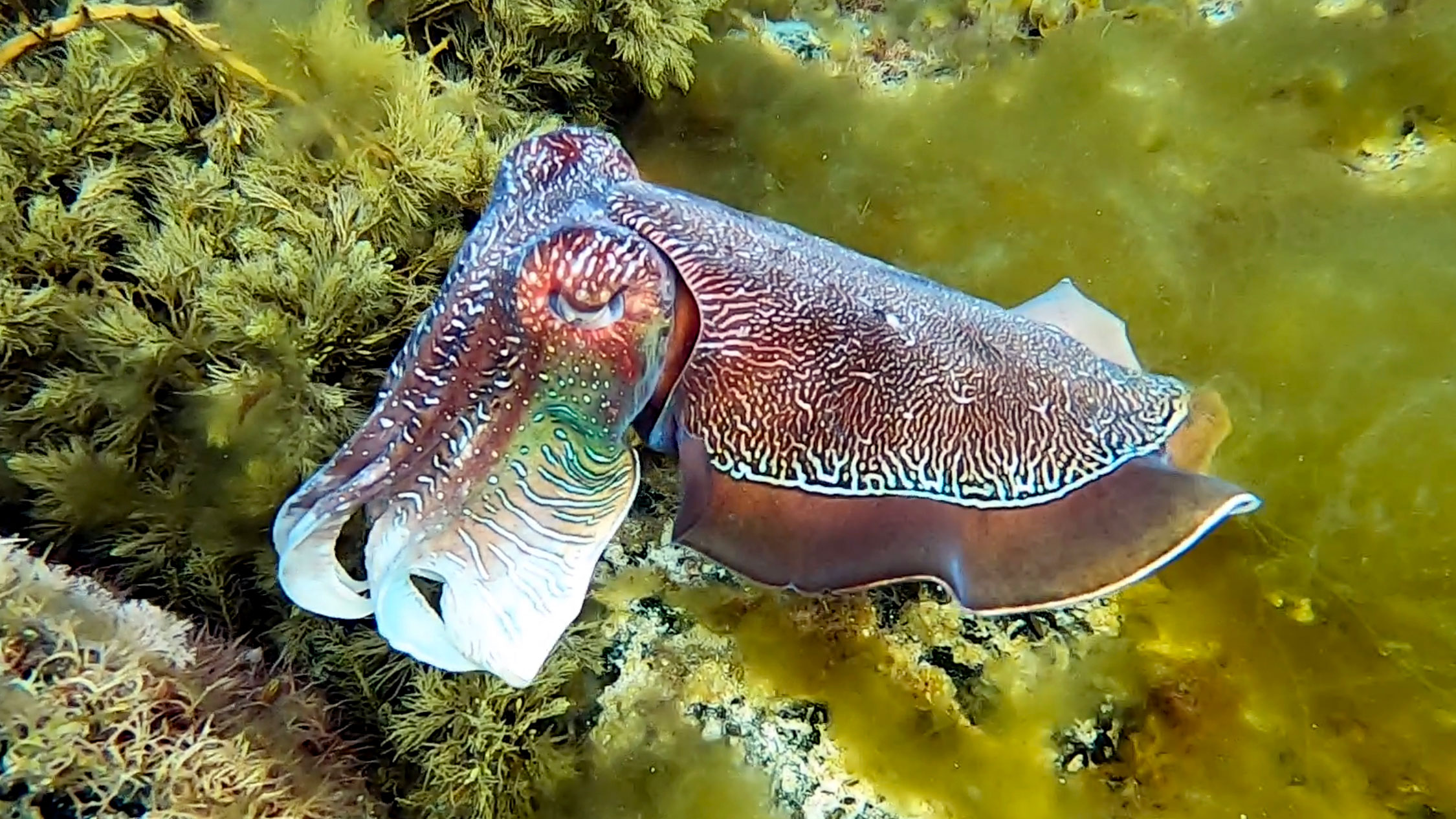Top 10 Masters of Marine Camouflage
“Seeing without being seen, dining without becoming dinner—these are the hallmarks of camouflage aces. Meet the true experts of concealment.“
N°10 Trumpetfish
*Camouflage, Color Change*

This fairly common reef fish frequently changes color to sneak up on unsuspecting prey and vacuum them up with its elongated snout. The fish also often assumes a vertical position to mimic the surrounding corals.
N°9 Pygmy Seahorse
*Camouflage*

Highly sought after by photographers, the pygmy seahorse, due to its small size, is exceptionally hard to spot. It exclusively resides on sea fans, mimicking their color and appearance. You can find them at depths ranging from 15 meters to 40 meters. For those seeking to observe some, Komodo’s dive sites, such as Batu Bolong and Castle Rock, offer opportunities.
N°8 Flatfish
*Camouflage, Burrowing*

Flatfishes blend into their sandy and pebbly environments by adopting the color of their surroundings. They also have the habit of burying themselves to hide from predators or surprise potential prey like shrimp and other mollusks.
N°7 Leafy Seadragon
*Camouflage*

The leafy seadragon has developed an uncanny resemblance to algae and kelp found in Australian coastal waters. It can also mimic drifting clumps of grass carried by ocean currents. Like seahorses, the male carries eggs under its tail for four to six weeks.
N°6 Stonefish
*Camouflage, Color Change*

Stonefish inhabit coral reefs in the Indo-Pacific. They are not always easy to spot, blending seamlessly into their rocky and coral-filled environment. This fish is renowned for being the world’s most venomous and you will be able to spot it nearly everywhere in Komodo National Park.
N°5 Ghost Pipefish
*Camouflage*

This peculiar fish hides in seagrass, sea fans, or other crinoids. It drifts with the currents, mimicking the shape and color of algae perfectly. Like the trumpetfish, it is often seen with its head down, ready to suction in its prey.
N°4 Leaf Scorpion Fish
*Camouflage, Color Change*

The leaf scorpion fish not only looks like a leaf but also behaves like one, undulating its body with the currents. This fish is a formidable predator for unsuspecting fish or crustaceans passing by. Spotted often on Siaba Besar and Mawan.
N°3 Frogfish
*Camouflage, Disruption of Contours*

This peculiar, misshapen fish is covered in tentacles that provide it with ideal camouflage in its natural habitat. It’s extremely challenging to spot when it remains motionless among sponges and algae.
N°2 Cuttlefish
*Reflection, Mimicry, Camouflage, Color Change*
The cuttlefish, also known as the “chameleon of the seas,” adapts its shape, brightness, and skin color to hide from danger, resembling a piece of coral, a clump of algae, or simply disappearing by mimicking the color of the sandy seabed.
N°1 Mimic Octopus
*Mimicry, Color Change*

The mimic octopus is an expert in shape-shifting, capable of imitating the appearance and movements of over fifteen species, including sea snakes, flying gurnards, flatfish, frogfish, brittle stars, giant crabs, shells, rays, sea anemones, jellyfish, and mantis shrimp.
Hard to imagine? Watch a video showcasing its various feats. If you dream of observing a mimic octopus, you have a chance to encounter one at Komodo’s dive sites, like in South Komodo, Wainilu or some secret muck dive sites we know.
Do not forget that most of those species can be found in Komodo National Park! Let’s try to find them during a PADI Course or a diving day trip.
“Seeing without being seen, dining without becoming dinner—these are the hallmarks of camouflage aces. Meet the true experts of concealment.“
N°10 Trumpetfish
*Camouflage, Color Change*

This fairly common reef fish frequently changes color to sneak up on unsuspecting prey and vacuum them up with its elongated snout. The fish also often assumes a vertical position to mimic the surrounding corals.
N°9 Pygmy Seahorse
*Camouflage*

Highly sought after by photographers, the pygmy seahorse, due to its small size, is exceptionally hard to spot. It exclusively resides on sea fans, mimicking their color and appearance. You can find them at depths ranging from 15 meters to 40 meters. For those seeking to observe some, Komodo’s dive sites, such as Batu Bolong and Castle Rock, offer opportunities.
N°8 Flatfish
*Camouflage, Burrowing*

Flatfishes blend into their sandy and pebbly environments by adopting the color of their surroundings. They also have the habit of burying themselves to hide from predators or surprise potential prey like shrimp and other mollusks.
N°7 Leafy Seadragon
*Camouflage*

The leafy seadragon has developed an uncanny resemblance to algae and kelp found in Australian coastal waters. It can also mimic drifting clumps of grass carried by ocean currents. Like seahorses, the male carries eggs under its tail for four to six weeks.
N°6 Stonefish
*Camouflage, Color Change*

Stonefish inhabit coral reefs in the Indo-Pacific. They are not always easy to spot, blending seamlessly into their rocky and coral-filled environment. This fish is renowned for being the world’s most venomous and you will be able to spot it nearly everywhere in Komodo National Park.
N°5 Ghost Pipefish
*Camouflage*

This peculiar fish hides in seagrass, sea fans, or other crinoids. It drifts with the currents, mimicking the shape and color of algae perfectly. Like the trumpetfish, it is often seen with its head down, ready to suction in its prey.
N°4 Leaf Scorpion Fish
*Camouflage, Color Change*

The leaf scorpion fish not only looks like a leaf but also behaves like one, undulating its body with the currents. This fish is a formidable predator for unsuspecting fish or crustaceans passing by. Spotted often on Siaba Besar and Mawan.
N°3 Frogfish
*Camouflage, Disruption of Contours*

This peculiar, misshapen fish is covered in tentacles that provide it with ideal camouflage in its natural habitat. It’s extremely challenging to spot when it remains motionless among sponges and algae.
N°2 Cuttlefish
*Reflection, Mimicry, Camouflage, Color Change*
The cuttlefish, also known as the “chameleon of the seas,” adapts its shape, brightness, and skin color to hide from danger, resembling a piece of coral, a clump of algae, or simply disappearing by mimicking the color of the sandy seabed.
N°1 Mimic Octopus
*Mimicry, Color Change*

The mimic octopus is an expert in shape-shifting, capable of imitating the appearance and movements of over fifteen species, including sea snakes, flying gurnards, flatfish, frogfish, brittle stars, giant crabs, shells, rays, sea anemones, jellyfish, and mantis shrimp.
Hard to imagine? Watch a video showcasing its various feats. If you dream of observing a mimic octopus, you have a chance to encounter one at Komodo’s dive sites, like in South Komodo, Wainilu or some secret muck dive sites we know.
Do not forget that most of those species can be found in Komodo National Park! Let’s try to find them during a PADI Course or a diving day trip.

10 Things You Should Never Do After Scuba Diving | Dragon Dive Komodo

The Best Time to Dive in Komodo National Park: Seasons, Conditions & Marine Life

Komodo vs Raja Ampat – Which Destination Is Better for Diving?

The Ultimate Guide to Indonesia’s Best Liveaboards: Dive Komodo, Alor & Raja Ampat



